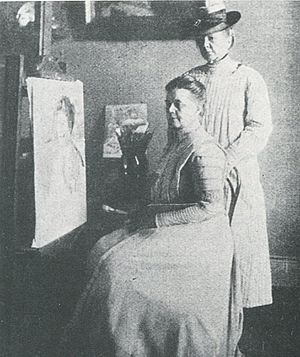Molly Cramer facts for kids
Quick facts for kids
Molly Cramer
|
|
|---|---|

Molly Cramer with her sister Helene in 1900
|
|
| Born | 25 June 1852 |
| Died | 18 January 1936 (aged 83) |
| Nationality | German |
| Education | Traditional Dutch school |
| Known for | Still life paintings of flowers and fruits, landscapes, portraits |
|
Notable work
|
Goldlack und Primeln ("Wallflowers and primroses"), 1899, Oil on canvas |
| Movement | Impressionism |
| Patron(s) | Alfred Lichtwark |
Molly Cramer (born June 25, 1852 – died January 18, 1936) was a talented German artist. She was known for her beautiful paintings of flowers, landscapes, and portraits. Molly first learned to paint in an older style called the Dutch School. Later in her life, her art changed to a more modern style known as Impressionism.
Contents
About Molly Cramer's Life
Molly Cramer grew up in Hamburg, Germany. Her family was quite wealthy. She had a sister named Helene Cramer, who also became a painter. Molly and Helene could only start their art training after their father passed away in 1882.
Early Art Training
Molly's first art teacher was Theobald Riefesell in Hamburg. She then studied with other painters like Carl Rodeck and Hinrich Wrage. In 1890, Molly traveled to Antwerp to learn from Eugène Joors. He taught her the traditional Dutch style of painting. With him, she mostly painted still lifes of flowers.
Painting Flowers and Fruits
When Molly returned to Hamburg, her flower and fruit paintings caught the eye of Alfred Lichtwark. He was the director of an art gallery. Lichtwark wanted artists to paint local plants. Molly followed his advice. She focused on painting flowers and fruits from her area. This was different from the popular Makartbouquets. These were fancy bouquets of artificial or dried flowers.
Molly Cramer's art was shown around the world. She exhibited her work at the 1893 World's Columbian Exposition in Chicago, Illinois. Her paintings were displayed in the Palace of Fine Arts and The Woman's Building.
Changing Art Style
After 1898, Molly started painting new subjects. She began to create landscapes and portraits. Her style became more impressionistic, which means it focused on light and color. Even with these new interests, flower still lifes remained a very important part of her work.
Supporting Other Artists
Molly and her sister Helene met younger artists in Hamburg. This happened through Alfred Lichtwark. Some of these artists were Ernst Eitner, Arthur Illies, and Paul Kayser. These younger artists started the Hamburg Artists' Club in 1897. The Cramer sisters showed their paintings with them. However, they were not official members of the club.
The Cramers' home became a popular meeting spot. Artists and art lovers would gather there. Molly Cramer also helped young artists. She bought their paintings and even paid for Ernst Eitner to go on study trips.
Molly Cramer's paintings were shown in many cities. These included Moscow, Budapest, London, and Chicago.
Later Life and Legacy
Towards the end of her life, Molly Cramer faced financial difficulties. She had to sell some of her own art collection. She eventually lived with a younger relative. Molly Cramer passed away on January 18, 1936, in Hamburg. The gravestones for Molly and Helene Cramer are at the Ohlsdorf Cemetery in Hamburg. They are located in a special area called the Garden of Women.
Selected Works
- Goldlack und Primeln ("Wallflowers and primroses"), 1899, Oil on canvas (Kaiser Wilhelm Museum Krefeld)
Images for kids
See also
 In Spanish: Molly Cramer para niños
In Spanish: Molly Cramer para niños
- List of German painters


